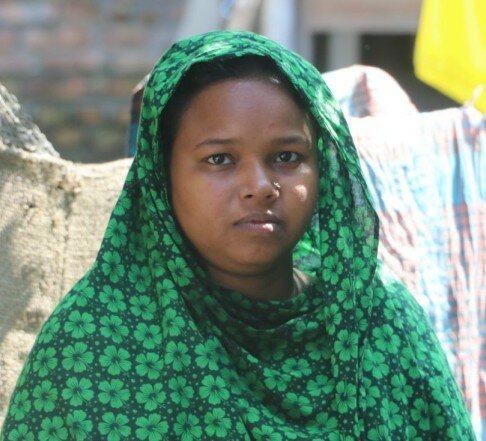Migration has always served as a strategy to adapt to changing conditions. But climate change has increasingly become a catalyzer that accelerates migration decisions by people in climate-vulnerable areas. This nexus is gaining traction among policymakers, the media and the public. Alarmingly, and misleadingly, it tends to be framed as a threat, particularly in the Global North, masking the reality of climate-induced migration being a predominantly domestic phenomenon.
Climate-induced migration, which is often perceived as an undesirable result of climate change, is a topic that will continue to be at the top of international cooperation’s agenda over the next decade. Helvetas has longstanding, broad expertise in natural resources management, climate change and safe migration. Lessons learned through projects in these areas have contributed to strengthening communities’ resilience and promoting an objective vision of this phenomenon that recognizes migration as a natural and legitimate strategy to climate change impact. Below, we share insights and good practices extracted from our experience across migration-related projects – a topic that will continue to be a priority for Helvetas for many years to come.
Coping strategies in climate change hotspots
Climate change is not a natural phenomenon; it is fueled by human actions that release emissions into the atmosphere and contribute to considerable warming, resulting in harmful consequences for ecosystems and humanity. The world has already warmed by over 1.1 degrees compared to pre-industrial times. This may sound moderate, but in actuality it translates to an increase in extreme weather events, fundamental changes in precipitation patterns, and temperature swells. In some areas of the world, known as climate change “hotspots,” living conditions have become harsher and risk becoming unbearable in the next decades. As a consequence, people migrate. By 2050, over 1 billion people may be on the move due to climate change and resulting extremes.
The southwest coast of Bangladesh is one of these hotspots. It is one of the most climate-vulnerable areas in the world, and offers an illustration of the massive scale of the concept of “loss and damage.” Communities in this low-lying river delta have always faced extreme weather events like storms and cyclones. Due to its location and topography, in this context climate change acts as a threat multiplier to an already sensitive and vulnerable coastal ecosystem. It is well-documented that the coastal regions of southwest Bangladesh are impacted by slow-onset climatic stresses (e.g., rising temperatures, salinity intrusion, erosion), and an increase in the occurrence and intensity of sudden onset disasters like floods, cyclones and storm surges.
Coastal communities in Bangladesh have been coping with the adverse impacts of extreme weather events since the 1970s, including through seasonal migration as a coping strategy. Recent scientific studies substantiate Helvetas’ longstanding experience on the ground that changing climate has reduced agricultural yields and narrowed the options for land- and water-based economic activities for people in the delta over the last 15 years. The exacerbation of the climate crisis is cutting off the livelihoods of millions of people and making migration one of the only options for adapting and coping. Work by the World Bank suggests that South Asia could experience an estimated 17 million to 36 million internal climate migrants by 2050 as a result of slow-onset climate changes. Around a third of this migrating population is expected to be in Bangladesh.
Migration may help households reduce their vulnerabilities to the impacts of climate change, but it also bears many serious risks such as indecent working conditions, human trafficking, forced labor and gender-based violence. The livelihoods of families left behind are also highly dependent on migration and money sent back by migrants. Remittances are vital for the resilience of (mostly women-led) families, and play an essential role in the economic vitalization of these areas. Though outmigration may reduce stress on fragile ecosystems, it is imperative to consider that it may create new vulnerabilities for migrants and dependencies, tensions, gender norm changes and burdens for families left behind.
Creating better understanding of a complex phenomenon
To gain more insights on this topic and shape future programming, Helvetas, in collaboration with the grassroots migrants’ organization Ovibashi Karmi Unnayan Program (OKUP), conducted multi-year action research with the support of the Climate Justice Resilience Fund (CJRF) and the City of Zurich (see the webinar about this research initiative). The research shows that migration is a complex and multi-causal phenomenon that can rarely be pinned down to one cause. Changing environmental and climatic conditions interact with other drivers of migration, whether they are social, political, economic or demographic. The research and case studies also show that people use and adapt their traditional and existing knowledge to cope (e.g., adapting agricultural practices such as cultivating saline-tolerant grass or fish).
“I can remember when there were lush green paddy fields in our village, even amid the large swath of parched, cracked earth and water-clogged areas,” said Shiuli, age 30, who was born and raised in Bangladesh’s Sundarbans area. “Now you can only see puddles. Water is everywhere. Nothing can grow. People cultivate shrimp in those fields. Poor people have very few opportunities to earn an income these days.”
Shiuli, age 30, who was born and raised in Bangladesh’s Sundarbans area
Exchanges with villagers during the research show that local economic opportunities are decreasing overall. Saltwater intrusion, as described by Shiuli, makes fields less suitable for growing crops and has detrimental health effects, particularly for children, the elderly, and pregnant and lactating women. Rising sea levels are fueling this trend. Alternatives to agriculture exist, but are often not accessible for low-income households like Shiuli’s that do not have their own land. Water-clogged areas can also be used for shrimp farming, but this requires substantial financial investment and does not offer job opportunities for unskilled workers, so it cannot be considered a viable adaptation strategy for many.
Given the overall decrease in local economic opportunities in hotspots, options are reaching their limits and exposing gaps in adaptive capacities. Communities are therefore looking for alternative livelihood options, which may be found locally or involve migrating to cities for income opportunities. What is clear is that migration has increased as a coping strategy over the last two decades and has become longer in duration and further in distance.
In this respect, the research assumes that migration can be an effective adaptation strategy if safe migration processes exist and future livelihood opportunities do not render migrants more vulnerable, also to the effects of climate change. If migrants are supported and informed in their decision-making, migration may offer the potential for economic and social development and a viable strategy to adapt to and anticipate climate change.
On the other hand, migration may also be “unsuccessful” and increase risks and vulnerabilities of both migrants and the families they leave behind, since decisions to migrate are often made ad hoc in response to an unplanned event. This can be a failed harvest, drought or a cyclone, but individual shocks may also prompt migration without preparation.
A lack of preparation brings a number of risks and often leads to so-called “failed adaptation strategies.” For example:
- Without preparation and an existing network in the destination area, migrants risk being exploited in search of income opportunities.
- When hopes for a better life for oneself and family are crushed by harsh realities in the areas of destination, chances are high that people return home, re-entering their former pattern.
The figure below illustrates these different migration experiences.

Individuals need resources and physical and mental ability to be on the move. Yet there are many people who stay behind for various reasons. These include women and children, since initial migration is mostly performed by able-bodied young men; the elder population and persons with disabilities; and, more globally, people who lack the financial and human resources to leave their home. Our in-depth case studies show that migration is not feasible for everyone, a conclusion that is substantiated by other research and contributes to the emerging discussions on involuntary/forced immobility. Indeed, underserved communities may be less able to migrate since climate change effects impact their assets and leave them without the resources and services necessary to move.
Operational solutions to major migration challenges
The action research findings were beneficial for Helvetas interventions in Bangladesh, including the Strengthened and Informative Migration Systems (SIMS) project, a Swiss Agency for Development and Cooperation (SDC) project, and the Panii Jibon project, which is supported by SDC and CJRF. The latter aims to build resilience and reduce the livelihood loss of climate change-affected communities, paying special attention to women and youth. This project supports people in changing their approach to growing food and managing their water resources in response to changing climate conditions.
Helvetas helps families make informed choices about climate-induced migration. The project’s strategy addresses the two primary migration dynamics: providing young women and men with the necessary skills to build an alternative livelihood in their villages or to move to urban areas equipped with suitable skills and knowledge. Helvetas Bangladesh works alongside these families to support them as they examine their migration options. This support involves informed decision making and skills development so families can also opt to earn a living without migrating. For households who choose to migrate, Helvetas offers these same services so that they can find decent employment once they arrive in a new place. The approach also includes helping households make economically informed decisions about migration through smarter use of remittances.
In July 2022 Helvetas started a new initiative in the same region that builds on Panii Jibon’s learnings and addresses the limits to adaptation. This endeavor is supported by the Scottish government, channeled through CJRF, and aims to learn from loss and damage on the ground and influence the decision-making at the United Nations Framework Convention on Climate Change. Helvetas and its partners Shushilan and DORP will create local-level awareness and host discussions on climate-induced migration, and will support skills development opportunities and alternative livelihood options at the local level (see additional publications on this work here and here).
Migration can be regarded as one effective and, above all, legitimate adaptation strategy to cope with the increasing frequency and intensity of climate extremes in a given area – either in combination with locally adapted livelihood options or as a practical solution when local options do not provide reasonable hope for recovery. As an adaptation strategy, migration must work for underserved, climate-affected communities by offering them long-term gender responsive and do no harm solutions instead of short-term fixes that might disempower them.
About the Authors
Helvetas’ Approach to Climate-Induced Migration
Helvetas implements a comprehensive, evidence and rights-based approach to climate-induced migration. Our vision is to help people to adapt to environmental and climate change pressures and to make migration a safer and more accessible choice.
Our interventions promote a migrant-centred approach that addresses risks and vulnerabilities related to climate-induced migration and seizes its opportunities and socio-economic benefits. This phenomenon must be considered holistically across the whole migration cycle – from providing alternatives to forced and unsafe migration through resilient and adaptive measures at the local level and in areas of origin to promoting a safe, planned and informed migration experience. Helvetas relies on its wide thematic expertise and multiple working areas to address this topic through cross-sectoral responses for people to stay, for people to move, and for people on the move.




